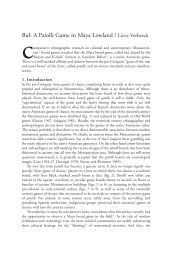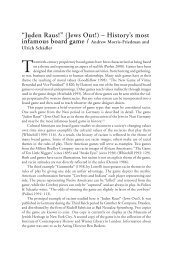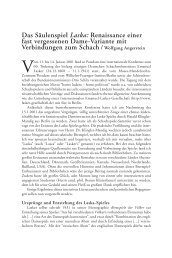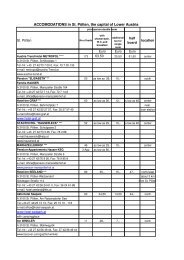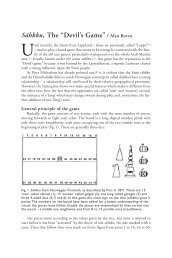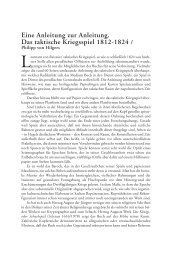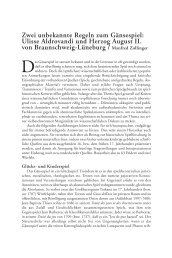Winning Openings in Dakon - Board Game Studies
Winning Openings in Dakon - Board Game Studies
Winning Openings in Dakon - Board Game Studies
You also want an ePaper? Increase the reach of your titles
YUMPU automatically turns print PDFs into web optimized ePapers that Google loves.
Human versus Mach<strong>in</strong>e Problem-Solv<strong>in</strong>g:<br />
<strong>W<strong>in</strong>n<strong>in</strong>g</strong> <strong>Open<strong>in</strong>gs</strong> <strong>in</strong> <strong>Dakon</strong> /<br />
Jeroen Donkers (1) , Alex de Voogt (2) , Jos Uiterwijk (1)<br />
Recently, a w<strong>in</strong>n<strong>in</strong>g open<strong>in</strong>g for the game of <strong>Dakon</strong> was found by hand. This<br />
sequence of moves leads to a direct w<strong>in</strong> for the beg<strong>in</strong>n<strong>in</strong>g player, without the<br />
opponent even giv<strong>in</strong>g the opportunity to move. In this paper we <strong>in</strong>vestigate how<br />
difficult it is to f<strong>in</strong>d such w<strong>in</strong>n<strong>in</strong>g open<strong>in</strong>gs for the computer and how the search<br />
methods differ for man and mach<strong>in</strong>e.<br />
Introduction<br />
<strong>Dakon</strong> is a game from the large group of mancala games that is played <strong>in</strong> South-East<br />
Asia. The game is played on a board with two rows of holes and a store on both sides (see<br />
figure 1). The two players sit at either side of the board (South or North). Each player<br />
has the own store at the right hand. At the start of the game, all holes (except the stores)<br />
are filled with an equal number of counters (which can be stones, seeds or shells). The<br />
number of counters <strong>in</strong> each hole is usually equal to the number of holes at one side. The<br />
objective of the game is to collect so many counters <strong>in</strong> the own store that the opponent<br />
cannot move anymore <strong>in</strong> the next round.<br />
Figure 1: A <strong>Dakon</strong> board with 6 holes per side.<br />
<strong>Dakon</strong> <strong>in</strong> the Maldives<br />
<strong>Dakon</strong> as it is described by Murray (1952), Deledicq & Popova (1977) and Russ<br />
(2000) is known as Sungka <strong>in</strong> the Philipp<strong>in</strong>es, and as Conka/Congka/Congkak <strong>in</strong><br />
Indonesia where it is also known as <strong>Dakon</strong>. The game was recently described for the<br />
Maldives (de Voogt 1999) where it is known as Ohvalhu. The w<strong>in</strong>n<strong>in</strong>g open<strong>in</strong>g was<br />
found by hand <strong>in</strong> the Maldives. A number of Maldivian women are familiar with this<br />
open<strong>in</strong>g and learned the sequence by heart. There are no tournaments of the game <strong>in</strong> the<br />
Maldives and the game is mostly played <strong>in</strong>-house by women and children and sometimes<br />
men. Dur<strong>in</strong>g Ramadhan it is a popular pastime and not <strong>in</strong>frequently women and<br />
men play together.<br />
There are four board-sizes known. Ohvalhu generally refers to a board of two rows<br />
of eight holes and two end-holes, but two rows of six, seven or even ten have also been
80<br />
B OARD G AMES S TUDIES 3, 2000<br />
documented. In those cases the number of counters by hole is adjusted to the number<br />
of holes <strong>in</strong> the row. There are a few variations of the game found and the rules most<br />
similar to <strong>Dakon</strong> are known throughout the islands.<br />
<strong>Dakon</strong> is used <strong>in</strong>stead of Ohvalhu s<strong>in</strong>ce Ohvalhu is not a name generally known or<br />
used <strong>in</strong> the literature of mancala. S<strong>in</strong>ce the rules are similar to those found elsewhere <strong>in</strong><br />
South-East Asia, a name from this area and used by all three sources mentioned above<br />
has been chosen for reasons of convenience.<br />
<strong>Dakon</strong> rules<br />
The rules for play<strong>in</strong>g <strong>Dakon</strong> are as follows: The first round beg<strong>in</strong>s with agree<strong>in</strong>g<br />
who is go<strong>in</strong>g to start. The player at move selects one of the holes on the own side of the<br />
board that conta<strong>in</strong>s any counters. The player picks the counters out of the hole and puts<br />
(“sows”) them one-by-one <strong>in</strong> the holes next to the start<strong>in</strong>g hole, <strong>in</strong> anti-clockwise direction.<br />
The player’s store also gets one counter, but the opponent’s store is skipped. When<br />
the amount of counters <strong>in</strong> the selected hole is large enough, then the hole from which<br />
the sow<strong>in</strong>g started will also receive a counter and the sow<strong>in</strong>g cont<strong>in</strong>ues until all counters<br />
are sown. This is called a lap. If the last counter of a lap is put <strong>in</strong> a hole that was not<br />
empty, all counters are taken out of that hole and sow<strong>in</strong>g cont<strong>in</strong>ues with the next hole.<br />
Such a sequence of laps will be called a move.<br />
If the last counter of a move is put <strong>in</strong> the player’s store, the player can select a new<br />
hole from the own side and move aga<strong>in</strong>. When the last counter of a move is put <strong>in</strong>to an<br />
empty hole at the player’s side, the counter <strong>in</strong> that hole and all counters <strong>in</strong> the opposite<br />
hole are captured and put <strong>in</strong> the player’s store and the player’s turn is over. When the<br />
last counter is put <strong>in</strong>to an empty hole at the opponent’s side, the turn is over without<br />
capture. A turn <strong>in</strong> <strong>Dakon</strong> thus consists of a sequence of moves that all but the last end<br />
<strong>in</strong> the player’s store.<br />
A round ends when one of the players cannot move anymore. All rema<strong>in</strong><strong>in</strong>g counters<br />
at the own side of the players are collected <strong>in</strong>to their stores. The counters are then<br />
redistributed as follows: from the left to the right, the holes are filled with the orig<strong>in</strong>al<br />
number of counters. Rema<strong>in</strong><strong>in</strong>g counters are put <strong>in</strong> the store. If the number of counters<br />
is too low to fill all holes, the holes that cannot be filled are marked with a leaf and are<br />
skipped <strong>in</strong> the next round. The player that won the last round starts play<strong>in</strong>g. The game<br />
is over when at the end of a round one of the players cannot even fill one hole.<br />
There are a number of variants of the game known. Sometimes <strong>Dakon</strong> is played by<br />
sow<strong>in</strong>g <strong>in</strong> clockwise direction and hav<strong>in</strong>g the store at the left-hand side. In the game of<br />
Sungka, as it is played <strong>in</strong> the Philipp<strong>in</strong>es, both players start simultaneously <strong>in</strong> the first<br />
round. The player that can move the longest starts the next round. The w<strong>in</strong>n<strong>in</strong>g open<strong>in</strong>g<br />
for <strong>Dakon</strong> (see below) was found by players of the Maldives where the game is known<br />
as Ohvalhu: they play <strong>in</strong> a clockwise direction.<br />
We will use the notation <strong>Dakon</strong>-n to <strong>in</strong>dicate the game of <strong>Dakon</strong> on a board with<br />
n holes on both sides and start<strong>in</strong>g with n counters <strong>in</strong> every hole.
DONKERS, A. DE VOOGT, J. UITERWIJK, WINNING OPENINGS IN DAKON 81<br />
<strong>W<strong>in</strong>n<strong>in</strong>g</strong> open<strong>in</strong>gs for <strong>Dakon</strong><br />
The game of <strong>Dakon</strong> has a special property that might also be present <strong>in</strong> other<br />
Mancala games: w<strong>in</strong>n<strong>in</strong>g open<strong>in</strong>gs. A w<strong>in</strong>n<strong>in</strong>g open<strong>in</strong>g for <strong>Dakon</strong>-n is a sequence of<br />
moves that form the first turn of the start<strong>in</strong>g player and that captures at least 2n2 - n<br />
counters. It is w<strong>in</strong>n<strong>in</strong>g because the opponent will have less than n counters left and cannot<br />
fill a s<strong>in</strong>gle hole <strong>in</strong> the next round, which means that the game is over. Of course,<br />
all moves of a w<strong>in</strong>n<strong>in</strong>g open<strong>in</strong>g but the last one must end <strong>in</strong> the player’s store.<br />
A hand-found w<strong>in</strong>n<strong>in</strong>g open<strong>in</strong>g<br />
The w<strong>in</strong>n<strong>in</strong>g open<strong>in</strong>g for <strong>Dakon</strong>-8 that was found by players of the Maldives is:<br />
1, 8, 8, 6, 4, 6, 2, 3, 7, 4, 5, 1, 8, 8, 3, 8, 4, 8, 7, 8, 5, 2, 7, 8, 6, 5, 6, 3, 7, 4, 5, 2,<br />
5, 8, 8, 6, 8, 3, 8, 5, 8, 7, 4, 8, 7, 8, 7, 8, 8, 6, 8, 7, 8, 4, 8, 6, 8, 3, 8, 6, 8, 5, 8, 6,<br />
1, 8, 7, 8, 5, 8, 4, 6, 7, 8, 8, 5, 6, 8, 3, 8, 1, 8, 7, 8, 2, 8, 6, 8, 5, 8, 6, 8, 3<br />
The numbers <strong>in</strong>dicate the holes that have to be selected at every move. Holes are<br />
numbered from 1 to 8 from left to right. This sequence consists of 93 moves and <strong>in</strong> total<br />
168 laps. The move with the largest number of laps for a s<strong>in</strong>gle move was 7 and occurred<br />
<strong>in</strong> move 77. After the complete sequence there are only three counters left <strong>in</strong> the<br />
opponent’s holes. Figure 2 shows the first 5 moves of this w<strong>in</strong>n<strong>in</strong>g open<strong>in</strong>g.<br />
Figure 2: First 9 situations of the w<strong>in</strong>n<strong>in</strong>g open<strong>in</strong>g for <strong>Dakon</strong>-8.<br />
Are such w<strong>in</strong>n<strong>in</strong>g open<strong>in</strong>gs always possible? This question can only be answered by<br />
exhaustive search. We can however show that w<strong>in</strong>n<strong>in</strong>g open<strong>in</strong>gs are not impossible. In<br />
<strong>Dakon</strong>-n, the m<strong>in</strong>imum number of counters that will rema<strong>in</strong> at the opponent’s side<br />
after any open<strong>in</strong>g sequence of moves is n divided by two, m<strong>in</strong>us 1, the result be<strong>in</strong>g rounded<br />
to below (or as a formula: n / 2 - 1).<br />
This can be proven as follows: a first observation is that dur<strong>in</strong>g a move, two adjacent<br />
holes at the opponent’s side of the board can never be empty at the same time, if the<br />
player is not actually sow<strong>in</strong>g. An opponent’s hole k can only become empty after a capture<br />
(which ends the turn) or when hole k is the end of a lap and conta<strong>in</strong>s more than one<br />
counter. In this case, hole k is the start of a new lap <strong>in</strong> the move. The previous hole (k -<br />
1) must have at least one counter, otherwise the lap could never have ended <strong>in</strong> hole k.<br />
The next hole (k + 1) will conta<strong>in</strong> at least one counter as soon as the seeds from hole k
82<br />
B OARD G AMES S TUDIES 3, 2000<br />
are sown. The fact that (before a capture) no adjacent opponent holes can be empty,<br />
means that the m<strong>in</strong>imum number of counters that have to be present at the opponent’s<br />
side is n / 2 , the m<strong>in</strong>imum number of non-empty holes. At the end of the turn, at most<br />
one of these counters could be captured, so the m<strong>in</strong>imum number of counters that will<br />
be left at the opponent’s side is n / 2 - 1.<br />
This result is no guarantee that a w<strong>in</strong>n<strong>in</strong>g open<strong>in</strong>g actually exists. It merely shows<br />
that a w<strong>in</strong>n<strong>in</strong>g open<strong>in</strong>g move could exist. Below we will show that there is no w<strong>in</strong>n<strong>in</strong>g<br />
open<strong>in</strong>g for <strong>Dakon</strong>-3.<br />
Human problem-solv<strong>in</strong>g<br />
Limitations of calculation<br />
Psychological research on mancala players is limited to developmental psychological<br />
f<strong>in</strong>d<strong>in</strong>gs concern<strong>in</strong>g Awele players (Retschitzki 1990) and cognitive psychological f<strong>in</strong>d<strong>in</strong>gs<br />
concern<strong>in</strong>g Bao players (de Voogt 1995). The experiments conducted on Bao can<br />
be related to the expertise shown by the Maldivian players. If only two rows of Bao are<br />
used and moves without captures are calculated then the complexity of Bao is similar to<br />
that of <strong>Dakon</strong>. There rema<strong>in</strong>s a small difference <strong>in</strong> rules and <strong>Dakon</strong> uses twice as many<br />
counters on the board. The results from Bao <strong>in</strong>dicate that <strong>in</strong>dependent from the number<br />
of holes per row, players are limited by the number of cycles they can calculate. A<br />
cycle is a move that travels the entire board once. For expert players this limitation is set<br />
to about four cycles while only <strong>in</strong> exceptional cases this may reach six.<br />
In <strong>Dakon</strong>, cycles are commonly not calculated. If they are calculated they are limited<br />
to one or perhaps two cycles. The high number of counters would make it necessary<br />
to take counters from the board <strong>in</strong> order to count them, which is not allowed. Also,<br />
the high number of counters would allow for moves cont<strong>in</strong>u<strong>in</strong>g for many cycles. For<br />
the above reason it is expected that a possible w<strong>in</strong>n<strong>in</strong>g open<strong>in</strong>g for the game of <strong>Dakon</strong><br />
has a m<strong>in</strong>imum number of moves that exceed one or two cycles. In such a case it is likely<br />
that the open<strong>in</strong>g is found ‘by hand’. As a consequence the likely open<strong>in</strong>g to be found<br />
tends to be the longest rather than the shortest <strong>in</strong> terms of number of moves. In other<br />
words, the human search method m<strong>in</strong>imizes the number of cycles per move while the<br />
computer search method could m<strong>in</strong>imize the number of moves themselves. If all the<br />
moves that can be calculated, i.e., not cont<strong>in</strong>u<strong>in</strong>g for more than one or two cycles, fail<br />
to cont<strong>in</strong>ue the series, then a s<strong>in</strong>gle move that cannot be calculated is easily identifiable<br />
as the next move. If dur<strong>in</strong>g the 93 moves there occurs a situation on the board <strong>in</strong> which<br />
a choice between various multi-cycle moves is necessary, there is an extra mnemonic aid<br />
necessary to locate the next move. Similarly, if there are more than one s<strong>in</strong>gle-cycle moves<br />
there is also an extra mnemonic aid necessary.<br />
Chunk<strong>in</strong>g<br />
In the cognitive psychological literature the concept of chunk<strong>in</strong>g is used to describe<br />
the memory process by which experts remember complicated positions or series of moves<br />
(Chase & Simon 1973, see also De Groot & Gobet 1996). The sow<strong>in</strong>g series described<br />
for <strong>Dakon</strong> <strong>in</strong>cludes 93 moves. This series has been learned by heart by various players.
DONKERS, A. DE VOOGT, J. UITERWIJK, WINNING OPENINGS IN DAKON 83<br />
Bao, Chess and other players who remember series of moves use chunk<strong>in</strong>g. This means<br />
that they group moves together <strong>in</strong> larger units or chunks. Experiments of this k<strong>in</strong>d <strong>in</strong>volve<br />
a limited time-span <strong>in</strong> which the players were asked to remember series of moves. In<br />
longer time-spans this chunk<strong>in</strong>g technique can be perfected and other mnemonic techniques<br />
could be used. In the case of <strong>Dakon</strong>, it is expected that the moves are grouped<br />
together. Although there are many ways of chunk<strong>in</strong>g a group of moves, it is argued here<br />
that those moves are grouped together that use the same procedure for locat<strong>in</strong>g the next<br />
move. For <strong>in</strong>stance, the first 10 moves form a group. Memory strategies for identify<strong>in</strong>g<br />
a group are endless and the dedicated reader who plays the 93 moves and tries to remember<br />
them will immediately devise such strategies as well.<br />
Solution f<strong>in</strong>d<strong>in</strong>g<br />
The limits of calculation and the chunk<strong>in</strong>g techniques may expla<strong>in</strong> part of the<br />
memorization process but do not necessarily expla<strong>in</strong> why this 93-moves w<strong>in</strong>n<strong>in</strong>g open<strong>in</strong>g<br />
was found by the players of the Maldives. It is expla<strong>in</strong>ed that the problem-solv<strong>in</strong>g<br />
strategy is likely to m<strong>in</strong>imize the number of cycles per move. This expla<strong>in</strong>s why the open<strong>in</strong>g<br />
is not equal to the shortest w<strong>in</strong>n<strong>in</strong>g open<strong>in</strong>g found by computer (see below).<br />
Another solution f<strong>in</strong>d<strong>in</strong>g approach is trial and error. The considerable number of possibilities<br />
of <strong>Dakon</strong> make this approach unlikely as an overall strategy. If the number of<br />
choices is small, i.e. the other choices can be calculated and found <strong>in</strong>adequate, the trialand-error<br />
approach is more appropriate.<br />
<strong>W<strong>in</strong>n<strong>in</strong>g</strong> open<strong>in</strong>gs, found by computer search<br />
A computer is different from the human m<strong>in</strong>d. Unlike humans, the computer excels<br />
<strong>in</strong> try<strong>in</strong>g all possibilities <strong>in</strong> a systematic and pa<strong>in</strong>stak<strong>in</strong>g manner. A computer can check<br />
all possible move sequences <strong>in</strong> order to f<strong>in</strong>d w<strong>in</strong>n<strong>in</strong>g open<strong>in</strong>gs for <strong>Dakon</strong>. In our computer<br />
program, the move sequences are generated <strong>in</strong> a specific way by a procedure called<br />
backtrack<strong>in</strong>g. At every stage, the program checks which moves are possible and<br />
performs (<strong>in</strong> memory) the first move from the left. This results <strong>in</strong> a new board situation<br />
<strong>in</strong> which the program aga<strong>in</strong> f<strong>in</strong>ds the possible moves and tries the first one. The program<br />
cont<strong>in</strong>ues until no moves can be done anymore. This can happen because the last move<br />
was a capture or because all holes on the player’s side are empty. The program now checks<br />
whether enough counters are be<strong>in</strong>g captured for the sequence to be a w<strong>in</strong>n<strong>in</strong>g open<strong>in</strong>g.<br />
If so, the sequence is written down. If not, the last move is undone (which is the actual<br />
backtrack<strong>in</strong>g) and the next possible move is tried. If all moves at a stage are tried, the<br />
move of the previous stage is undone and the search cont<strong>in</strong>ues. The process cont<strong>in</strong>ues<br />
until all sequences are checked. F<strong>in</strong>d<strong>in</strong>g a w<strong>in</strong>n<strong>in</strong>g open<strong>in</strong>g is fast. Up to <strong>Dakon</strong>-18,<br />
w<strong>in</strong>n<strong>in</strong>g open<strong>in</strong>gs are found with<strong>in</strong> seconds on a standard desktop PC (300 Mhz<br />
Pentium II, the program has been written <strong>in</strong> the language Java).<br />
It is possible to adjust the program so that it f<strong>in</strong>ds all w<strong>in</strong>n<strong>in</strong>g open<strong>in</strong>g. For <strong>Dakon</strong>-<br />
2 (which is obviously never played), there appear to be only 2 possible sequences of<br />
moves, and both sequences are w<strong>in</strong>n<strong>in</strong>g open<strong>in</strong>gs. <strong>Dakon</strong>-3 happens to have no w<strong>in</strong>n<strong>in</strong>g<br />
open<strong>in</strong>gs at all among the 13 possible move sequences. For <strong>Dakon</strong> with more than 3
84<br />
B OARD G AMES S TUDIES 3, 2000<br />
holes, w<strong>in</strong>n<strong>in</strong>g open<strong>in</strong>gs exist always, at least for up to 18 holes per side. <strong>Dakon</strong>-4 has<br />
147 possible move sequences of which 7 are w<strong>in</strong>n<strong>in</strong>g open<strong>in</strong>gs, <strong>Dakon</strong>-5 has 1,371 possible<br />
move sequences of which only 2 are w<strong>in</strong>n<strong>in</strong>g open<strong>in</strong>gs and <strong>Dakon</strong>-6 has as many<br />
as 7,611,977 possible move sequences and 41,263 w<strong>in</strong>n<strong>in</strong>g open<strong>in</strong>gs. For <strong>Dakon</strong> with<br />
more than 6 holes per side, the number of possible move sequences is too large to check.<br />
At least 50 million sequences where counted for <strong>Dakon</strong>-7, which took 3 full days of<br />
computation. If one looks at the growth rate of the number of possible sequences, the<br />
total time to check <strong>Dakon</strong>-7 might take as much as 6000 days on our computer system!<br />
This means that the exact number of w<strong>in</strong>n<strong>in</strong>g open<strong>in</strong>g moves for <strong>Dakon</strong> with more than<br />
six holes per side could not be determ<strong>in</strong>ed by us.<br />
Maximum-capture w<strong>in</strong>n<strong>in</strong>g open<strong>in</strong>gs<br />
Because the number of w<strong>in</strong>n<strong>in</strong>g open<strong>in</strong>gs is so large, it is <strong>in</strong>terest<strong>in</strong>g to f<strong>in</strong>d special<br />
types of w<strong>in</strong>n<strong>in</strong>g open<strong>in</strong>gs and compare these to the hand-found solution. The first type<br />
is a w<strong>in</strong>n<strong>in</strong>g open<strong>in</strong>g which captures as many counters as possible. Table 1 gives an overview<br />
of the results. It appears that for <strong>Dakon</strong> with more than 5 holes, w<strong>in</strong>n<strong>in</strong>g open<strong>in</strong>gs<br />
exist that capture the theoretical maximum. For <strong>Dakon</strong>-4 and <strong>Dakon</strong>-5 all w<strong>in</strong>n<strong>in</strong>g open<strong>in</strong>gs<br />
fail to capture the theoretical maximum number of counters.<br />
Shortest w<strong>in</strong>n<strong>in</strong>g open<strong>in</strong>gs<br />
Memoriz<strong>in</strong>g a long w<strong>in</strong>n<strong>in</strong>g open<strong>in</strong>g is difficult, so it is also of <strong>in</strong>terest to f<strong>in</strong>d those<br />
w<strong>in</strong>n<strong>in</strong>g open<strong>in</strong>gs that consist of the least number of moves. To f<strong>in</strong>d these open<strong>in</strong>gs, the<br />
search procedure must be adapted slightly. Whenever a w<strong>in</strong>n<strong>in</strong>g open<strong>in</strong>g of a certa<strong>in</strong><br />
length has been found, all further move sequences that are at least as long can be skipped.<br />
This speeds up the search and enables us even to f<strong>in</strong>d the shortest w<strong>in</strong>n<strong>in</strong>g open<strong>in</strong>g<br />
for <strong>Dakon</strong> with 8 holes per side (see Table 2). Observe that this solution has only 29<br />
moves, aga<strong>in</strong>st the 93 moves of the hand-found solution. For <strong>Dakon</strong>-9 and <strong>Dakon</strong>-10,<br />
the time for complet<strong>in</strong>g the search took too long: it was aborted after 4 days of comput<strong>in</strong>g.<br />
The best results so far are marked with an asterisk <strong>in</strong> the table.<br />
Human-like w<strong>in</strong>n<strong>in</strong>g open<strong>in</strong>gs<br />
A next question we can pose is whether the computer is able to f<strong>in</strong>d “human-like”<br />
w<strong>in</strong>n<strong>in</strong>g open<strong>in</strong>gs. A first attempt is to f<strong>in</strong>d w<strong>in</strong>n<strong>in</strong>g open<strong>in</strong>gs <strong>in</strong> which the maximum<br />
number of laps per move is as small as possible and, with<strong>in</strong> this, the total number of<br />
moves is as small as possible. Table 3 (p. 88) shows our f<strong>in</strong>d<strong>in</strong>gs. It appears that as the<br />
number of holes per side <strong>in</strong>creases, the lap count decreases and stabilizes at 4 or 5.<br />
Asterisks <strong>in</strong> the third column of table aga<strong>in</strong> <strong>in</strong>dicate that some of the computations have<br />
been aborted and only best results found are given. The asterisks <strong>in</strong> the second column<br />
<strong>in</strong>dicate that we could not f<strong>in</strong>d, with<strong>in</strong> reasonable time, any w<strong>in</strong>n<strong>in</strong>g open<strong>in</strong>gs for smaller<br />
lap counts.<br />
The second attempt to f<strong>in</strong>d human-like w<strong>in</strong>n<strong>in</strong>g open<strong>in</strong>gs is to m<strong>in</strong>imize the number<br />
of cycles per move. This is done as follows: first the maximum number of cycles per
DONKERS, A. DE VOOGT, J. UITERWIJK, WINNING OPENINGS IN DAKON 85<br />
# Holes # Counters left # Solutions Example solution<br />
4 2 2 1, 4, 2, 4, 2, 2, 2, 4, 3, 1, 4, 4, 3, 4, 1<br />
5 4 2 1, 5, 3, 1, 5, 2, 5, 5, 4, 3, 1, 3, 5, 5, 4, 3, 5,<br />
5, 1, 4, 2, 5, 1, 5, 2, 5, 3<br />
6 2 415 1, 5, 1, 3, 2, 3, 5, 2, 3, 5, 2, 3, 1, 3, 6, 2, 2,<br />
5, 2, 2, 6, 4, 6, 5, 2, 5, 3, 6, 6, 2, 6, 3, 6, 5,<br />
6, 1<br />
7 2 Unknown 1, 7, 7, 5, 3, 5, 7, 7, 4, 3, 4, 5, 6, 3, 1, 5, 1,<br />
7, 2, 5, 3, 7, 7, 4, 7, 1, 5, 3, 7, 7, 2, 4 ,7 ,7 ,6<br />
7, 5, 7, 3, 2, 4, 1, 6, 4, 7, 7, 6, 3, 7, 3, 7, 5,<br />
7, 6, 7, 1<br />
8 3 Unknown 1, 8, 8, 6, 7, 8, 8, 4, 7, 6, 8, 5, 8, 8, 5, 5, 7,<br />
1, 7, 2, 7, 4, 2, 8, 5, 6, 3, 8, 7, 6, 5, 8, 8, 3,<br />
1, 7, 2, 7, 4, 5, 6, 8, 3, 7, 8, 5, 4, 8, 7, 8, 1,<br />
4, 7, 8, 8, 6, 8, 1, 8, 3, 8, 5, 7<br />
9 3 Unknown 1, 9, 9, 7, 9, 9, 4, 8, 9, 5, 7, 5, 5, 8, 9, 8, 7,<br />
9, 6, 7, 9, 3, 6, 8, 9, 8, 7, 9, 9, 7, 9, 3, 6, 2,<br />
8, 8, 3, 2, 7, 8, 8, 9, 8, 4, 6, 9, 3, 9, 5, 9, 7,<br />
9, 9, 5, 3, 4, 9, 8, 2, 8, 4, 3, 9, 6, 9, 3, 9, 7,<br />
9, 1, 9, 4, 9, 6, 9, 8, 9, 3<br />
10 4 Unknown 1, 10, 10, 8, 10, 9, 10, 10, 7, 6, 10, 8, 10, 10,<br />
10, 10, 7, 3, 8, 6, 10, 9, 7, 5, 6, 10, 8, 6, 7, 5,<br />
6, 8, 9, 4, 1, 1, 6, 10, 7, 9, 5, 8, 3, 8, 5, 8, 7,<br />
8, 4, 6, 1, 4, 5, 2, 1, 7, 6, 8, 1, 8, 6, 5, 8, 10,<br />
9, 10, 6, 10, 5, 10, 10, 8, 10, 7, 10, 9, 8, 9,<br />
10, 8, 10, 1, 10, 8, 10, 7, 10, 5, 10, 9, 10, 3,<br />
10, 5, 10, 4, 10, 5, 10, 9, 10, 7<br />
Table 1: Maximum-capture w<strong>in</strong>n<strong>in</strong>g open<strong>in</strong>gs.<br />
# Holes Length Example solution<br />
4 12 1, 4, 2, 4, 2, 2, 2, 4, 3, 1, 4, 4, 3, 4, 1<br />
5 24 1, 5, 3, 1, 5, 2, 5, 5, 4, 3, 1, 3, 5, 5, 4, 3, 5, 5, 1, 4,<br />
2, 5, 1, 5, 2, 5, 3<br />
6 19 1, 5, 2, 6, 6, 1, 4, 6, 2, 6, 3, 2, 6, 6, 4, 6, 5, 6, 3<br />
7 25 1, 7, 4, 1, 6, 7, 4, 3, 1, 1, 4, 1, 4, 7, 2, 1, 5, 2, 3, 6,<br />
1, 5, 5, 7, 1<br />
8 29 1, 4, 4, 5, 3, 8, 4, 2, 1, 5, 5, 4, 6, 5, 5, 2, 3, 6, 4, 7,<br />
6, 7, 8, 8, 8, 5, 8, 8, 6<br />
9 41* 1, 9, 9, 7, 9, 9, 4, 8, 9, 5, 7, 5, 5, 4, 3, 8, 8, 6, 8, 1,<br />
1, 7, 9, 9, 6, 5, 7, 9, 9, 9, 6, 5, 7, 9, 8, 5, 4, 9, 8, 9, 7<br />
10 68* 1, 10, 10, 8, 10, 9, 10, 10, 7, 6, 10, 8, 10, 10, 10,<br />
10, 7, 3, 8, 6, 10, 9, 7, 5, 6, 10, 8, 6, 7, 5, 6, 8, 9, 4,<br />
1, 1, 6, 10, 5, 9, 3, 7, 10, 5, 9, 6, 9, 4, 10, 7, 10, 7,<br />
7, 5, 10, 4, 10, 6, 10, 1, 7, 8, 8, 10, 4, 8, 10, 10, 8<br />
Table 2: Shortest w<strong>in</strong>n<strong>in</strong>g open<strong>in</strong>gs. (* shortest found so far)
86<br />
B OARD G AMES S TUDIES 3, 2000<br />
# Holes Lap Count Length Example solution<br />
4 8 13 1, 4, 2, 4, 2, 2, 2, 4, 3, 4, 1, 4, 3<br />
5 6 27 1, 5, 3, 1, 5, 2, 5, 5, 4, 3, 1, 3, 5, 5, 4, 3, 5,<br />
5, 1, 4, 2, 5, 1, 5, 2, 5, 3<br />
6 5 31 1, 6, 4, 2, ,4 ,3, 3, 4, 5, 3, 5, 2, 1, 5, 2, 5, 2,<br />
4, 5, 2, 5, 6, 2, 5, 4, 6, 1, 6, 6, 3, 4<br />
7 5 49 1, 7, 7, 5, 3, 5, 7, 5, 6, 7, 7, 3, 1, 3, 6, 5, 6,<br />
4, 1, 2, 2, 5, 4, 6, 2, 7, 6, 7, 3, 7, 6, 1, 6, 7,<br />
1, 7, 6, 7, 5, 6, 7, 5, 7, 3, 1, 6, 7, 1, 7<br />
8 4 75* 1, 8, 8, 6, 4, 6, 2, 3, 7, 6, 7, 8, 8, 5, 3, 6, 2,<br />
4, 7, 6, 5, 8, 8, 3, 8, 5, 2, 4, 8, 1, 5, 4, 2, 5,<br />
4, 7, 5, 8, 2, 7, 8, 4, 8, 7, 8, 3, 8, 5, 6, 7, 3,<br />
8, 8, 1, 8, 5, 8, 4, 7, 8, 5, 1, 8, 8, 2, 8, 4, 8,<br />
7, 8, 5, 8, 6, 8, 1<br />
9 5* 103* 1, 5, 1, 4, 6, 4, 5, 3, 1, 4, 2, 1, 3, 9, 6, 4, 8,<br />
4, 7, 2, 3, 9, 9, 5, 9, 8, 7, 4, 9, 7, 9, 7, 4, 5,<br />
3, 9, 8, 2, 4, 5, 6, 7, 1, 6, 3, 7, 5, 2, 8, 2, 7,<br />
6, 9, 3, 1, 9, 9, 8, 8, 6, 9, 6, 7, 7, 4, 9, 8, 9,<br />
6, 9, 7, 8, 2, 5, 9, 1, 9, 9, 8, 9, 6, 9, 4, 9, 8,<br />
9, 1, 9, 6, 9, 5, 9, 6, 9, 8, 9, 3, 9, 4, 9, 5, 9, 6<br />
10 5* 129* 1, 6, 1, 7, 2, 3, 1, 6, 4, 4, 2, 9, 2, 4, 8, 3, 4,<br />
8, 1, 10, 5, 10, 6, 9, 7, 1, 8, 1, 1, 6, 7, 8, 5,<br />
1, 7, 5, 10, 7, 1, 2, 9, 8, 4, 9, 1, 2, 7, 8, 2, 5,<br />
9, 10, 7, 3, 1, 10, 7, 10, 9, 2, 4, 3, 9, 8, 7, 9,<br />
8, 9, 6, 5, 6, 1, 7, 6, 5, 9, 7, 10, 10, 8, 1, 10,<br />
5, 8, 10, 1, 6, 5, 10, 10, 4, 5, 9, 8, 10, 10, 9,<br />
4, 1, 10, 8, 7, 10, 10, 6, 9, 10, 10, 8, 10, 5,<br />
10, 1, 10, 7, 10, 2, 10, 3, 10, 5, 10, 9, 10, 6,<br />
10, 8, 10, 4<br />
Table 3: M<strong>in</strong>imum-lap-count w<strong>in</strong>n<strong>in</strong>g open<strong>in</strong>gs. (* best found so far)<br />
move (measured <strong>in</strong> the number of counters <strong>in</strong>volved <strong>in</strong> the move) is m<strong>in</strong>imized and<br />
with<strong>in</strong> this set of solutions, the number of moves that exceed 1 cycle is m<strong>in</strong>imized. For<br />
<strong>Dakon</strong>-8, it appears that all solutions have a move that at least <strong>in</strong>volves 39 counters<br />
(about 2.4 cycles). The best w<strong>in</strong>n<strong>in</strong>g open<strong>in</strong>g for <strong>Dakon</strong>-8 counts 86 moves among<br />
which only 22 exceed one cycle:<br />
1, 8, 8, 6, 4, 6, 2, 1, 7, 5, 6, 8, 8, 2, 8, 4, 8, 1, 8, 7, 7, 1, 4, 6, 2, 6, 5, 4, 3, 2, 8, 8,<br />
7, 6, 2, 1, 3, 6, 8, 4, 6, 3, 8, 6, 3, 8, 5, 8, 4, 8, 6, 6, 3, 8, 5, 4, 1, 8, 7, 8, 2, 4, 8, 8,<br />
5, 8, 7, 8, 7, 8, 5, 8, 1, 8, 5, 3, 2, 8, 7, 8, 3, 8, 4, 8, 5, 7<br />
Observe that the start of this w<strong>in</strong>n<strong>in</strong>g open<strong>in</strong>g equals the hand-found w<strong>in</strong>n<strong>in</strong>g open<strong>in</strong>g.
DONKERS, A. DE VOOGT, J. UITERWIJK, WINNING OPENINGS IN DAKON 87<br />
Analysis of the hand-found w<strong>in</strong>n<strong>in</strong>g open<strong>in</strong>g<br />
The hand-found w<strong>in</strong>n<strong>in</strong>g open<strong>in</strong>g appears to have three characteristics. The number<br />
of cycles of each move is low with only one move which exceeds three cycles. The<br />
number of moves with more than one cycle is 22. The best w<strong>in</strong>n<strong>in</strong>g open<strong>in</strong>g found by<br />
computer has only 13 such moves but they frequently exceed three cycles. The best w<strong>in</strong>n<strong>in</strong>g<br />
open<strong>in</strong>g with the most s<strong>in</strong>gle-cycle moves and the lowest maximum cycle appears<br />
86 moves long and has 22 moves with go beyond one cycle. This predicts with some<br />
accuracy the hand-found sequence also because the start of the move is identical.<br />
An analysis of each move <strong>in</strong> the hand-found sequence shows that moves 10, 13, 34,<br />
42, 46, 48, 65-67 and 77 has more than one option that could be successful and m<strong>in</strong>imize<br />
the number of cycles. They do not adhere to the m<strong>in</strong>imal cycle requirement, while<br />
all other moves are optimal accord<strong>in</strong>g to the above analysis.<br />
Although this expla<strong>in</strong>s why this w<strong>in</strong>n<strong>in</strong>g open<strong>in</strong>g was found <strong>in</strong>stead of others, it<br />
does not expla<strong>in</strong> how the players could have analyzed so many options. The first 10<br />
moves show a clear regularity when played. The last 10 moves are most likely necessary<br />
moves, mean<strong>in</strong>g that any other option would lead to an immediate halt to the sequence.<br />
The middle moves can only be expla<strong>in</strong>ed if the number of options that cont<strong>in</strong>ue the<br />
sequence is limited. In that case the trial-and-error method <strong>in</strong> comb<strong>in</strong>ation with cycle<br />
calculations predict a successful search with<strong>in</strong> a reasonable time-span. It appears that<br />
when the number of possible cont<strong>in</strong>uations is high (more than 5) there is a reasonable<br />
chance that a less optimal choice is taken <strong>in</strong> the hand-found solution. Move 10, 13, 34,<br />
66 and 67 were taken from a selection of six possible cont<strong>in</strong>uations. Move 46 and 48<br />
were taken from eight possible cont<strong>in</strong>uations, <strong>in</strong>deed the maximum number of choices<br />
and the only two times that these maximums occurred <strong>in</strong> the hand-found open<strong>in</strong>g.<br />
Conclusions<br />
There are solutions to <strong>Dakon</strong> games of sizes 2x4 to 2x10, sizes that are also known<br />
<strong>in</strong> the mancala literature. The small number of w<strong>in</strong>n<strong>in</strong>g open<strong>in</strong>gs <strong>in</strong> relation to the total<br />
number of possible move sequences does not make a hand-found solution likely. The<br />
w<strong>in</strong>n<strong>in</strong>g open<strong>in</strong>g that was found <strong>in</strong> the Maldives appears to have particular characteristics<br />
that expla<strong>in</strong> the problem-solv<strong>in</strong>g method of the players. It appears that the calculation<br />
ability of the players <strong>in</strong>fluences the type of solution they have found. Also, regular<br />
<strong>in</strong>itial sequences and necessary end sequences determ<strong>in</strong>e a large portion of the moves<br />
they played. Although the characteristics of the solution can be expla<strong>in</strong>ed, the accomplishment<br />
itself can only be laudated as an act of mastership comparable to the expertise<br />
shown <strong>in</strong> other board games of this k<strong>in</strong>d.<br />
It is shown that computer science and cognition <strong>in</strong> general has much to ga<strong>in</strong> from<br />
games analyses such as these. The present study exemplifies the results that could be ga<strong>in</strong>ed<br />
from such studies and should encourage further research of this k<strong>in</strong>d.<br />
Acknowledgements<br />
We wish to thank Mohammed Rashid and his family Aim<strong>in</strong>ath Sofeenaz and Zahira<br />
Ibrahim as well as Angeli and his friends Nweema Mohamed, Fathmath Ahmed, Aishath
88<br />
B OARD G AMES S TUDIES 3, 2000<br />
Liziyan. Most of all, we are grateful to Ahmed Siraj, Sameera Adam, Ali Misbah, Ashath<br />
Aboobakuru, Arifa Ali, Fathumath Ratheeba, Aim<strong>in</strong>ath Moosa and others at Male and<br />
Laamu Atoll. The Pr<strong>in</strong>s Bernhard Foundation and the International Institute for Asian<br />
<strong>Studies</strong> are acknowledged for their f<strong>in</strong>ancial support and facilities which made this research<br />
possible.<br />
References<br />
Chase, W.G. and H.A. Simon 1973. The m<strong>in</strong>d’s eye <strong>in</strong> chess. In: W.G. Chase (Ed.)<br />
Visual Information Process<strong>in</strong>g, XVIII: 269-308.<br />
Deledicq, A. and A. Popova 1977. Wari et solo. Le jeu de calcul africa<strong>in</strong>, Paris, Cedic.<br />
Groot, A.D. de and F. Gobet 1996. Perception and Memory <strong>in</strong> Chess: <strong>Studies</strong> <strong>in</strong> heuristics<br />
of the professional eye. Assen, Van Gorcum.<br />
Murray, H.J.R. 1952. A History of board games other than chess. Oxford, Clarendon Press.<br />
Retschitzki, J. 1990. Stratégies des joueurs d’awélé. Paris, L’Harmattan.<br />
Russ, L. 2000. The complete Mancala games book. New York, Marlowe & Co.<br />
Voogt, A.J. de 1995. Limits of the M<strong>in</strong>d: Towards a characterisation of Bao mastership.<br />
Ph.D. thesis. Leiden, Research School CNWS, Leiden University.<br />
Voogt, A.J. de 1999. Distribution of mancala board games: a methodological <strong>in</strong>quiry.<br />
In: <strong>Board</strong> <strong>Game</strong>s <strong>Studies</strong>, 2: 104-114.<br />
Notes<br />
1. Department of Computer Science, Universiteit Maastricht, email: donkers@cs.unimaas.nl;<br />
,uiterwijk@cs.unimaas.nl<br />
2. Universiteit Leiden, email: devoogt@rullet.leidenuniv.nl



